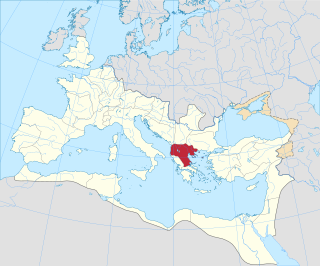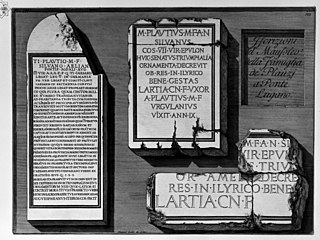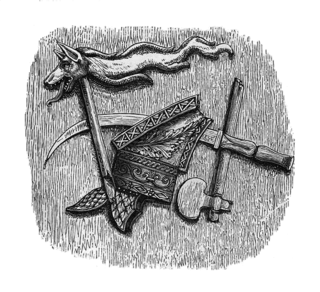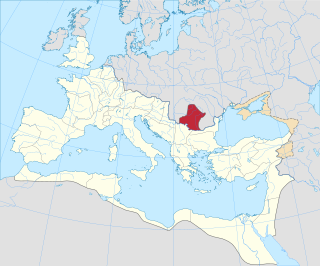Related Research Articles

Moesia was an ancient region and later Roman province situated in the Balkans south of the Danube River. As a Roman domain Moesia was administered at first by the governor of Noricum as 'Civitates of Moesia and Triballia'. It included most of the territory of modern eastern Serbia, Kosovo, north-eastern Albania, northern parts of North Macedonia, Northern Bulgaria, Romanian Dobruja and small parts of Southern Ukraine.

The Year of the Four Emperors, AD 69, was the first civil war of the Roman Empire, during which four emperors ruled in succession: Galba, Otho, Vitellius, and Vespasian. It is considered an important interval, marking the transition from the Julio-Claudians, the first imperial dynasty, to the Flavian dynasty. The period witnessed several rebellions and claimants, with shifting allegiances and widespread turmoil in Rome and the provinces.

The Roman provinces were the administrative regions of Ancient Rome outside Roman Italy that were controlled by the Romans under the Roman Republic and later the Roman Empire. Each province was ruled by a Roman appointed as governor.

Legio IV Scythica, also written as Legio IIII Scythica, was a legion of the Imperial Roman army founded in c. 42 BC by the Roman general Mark Antony, for his campaign against the Parthian Empire, hence its other cognomen, Parthica. The legion was still active in the Roman province of Syria in the early 5th century.

Gnaeus Minicius Faustinus Sextus Julius Severus was an accomplished Roman general of the 2nd century. He also held the office of suffect consul in the last three months of 127 with Lucius Aemilius Juncus as his colleague.
Caerellius Priscus is the name given to the man on an inscription recovered at Mogontiacum (Mainz), set up by a governor of Germania Superior who was afterwards governor of Roman Britain in the late 170s.

Macedonia was a province of ancient Rome, encompassing the territory of the former Antigonid Kingdom of Macedonia, which had been conquered by the Roman Republic in 168 BC at the conclusion of the Third Macedonian War. The province was created in 146 BC, after the Roman general Quintus Caecilius Metellus defeated Andriscus of Macedon, the last self-styled King of Macedonia in the Fourth Macedonian War. The province incorporated the former Kingdom of Macedonia with the addition of Epirus, Thessaly, and parts of Illyria, Paeonia and Thrace.

Legio VII Claudia was a legion of the Ancient Roman army.

Tiberius Plautius Silvanus Aelianus was a Roman patrician who twice served as consul, in 45 and 74 AD. He was the natural son of Lucius Aelius Lamia and the adopted son of Marcus Plautius Silvanus, brother of Plautia Urgulanilla, first wife of the emperor Claudius. It is known he offered up the prayer as pontifex when the first stone of the new Capitol was laid in 70 AD. In some ancient sources he is referred to as Plautius Aelianus, but we learn from an inscription that his full name was Tiberius Plautius Silvanus Aelianus, and that he held many important military commands.
Gnaeus Pompeius Longinus was a Roman senator and general. He was the 5th legate of Judaea from 85 to 89 and held the suffect consulship in the nundinium of September–October 90 as the colleague of Lucius Albius Pullaienus Pollio. He was deceived into a trap by Decebalus during Trajan's Second Dacian War, and rather than provide an advantage to the Dacian king, killed himself.

Duras, also known as Duras-Diurpaneus, was king of the Dacians between maybe AD 69 and 87, during the time that Domitian ruled the Roman Empire. Duras' immediate successor was Decebalus.
Sextus Vettulenus Cerialis was a Roman senator and military commander, the 1st legate of Judaea. He was an early supporter of Vespasian, who appointed Cerialis suffect consul in either 72 or 73.

Roman Dacia was a province of the Roman Empire from 106 to 271–275 AD. Its territory consisted of what are now the regions of Oltenia, Transylvania and Banat. During Roman rule, it was organized as an imperial province on the borders of the empire. It is estimated that the population of Roman Dacia ranged from 650,000 to 1,200,000. It was conquered by Trajan (98–117) after two campaigns that devastated the Dacian Kingdom of Decebalus. However, the Romans did not occupy its entirety; Crișana, Maramureș, and most of Moldavia remained under the Free Dacians.
Lucius Minicius Natalis Quadronius Verus was a Roman statesman and military leader who served as the Proconsul of Africa from 153 to 154. He was the first known Olympic champion to have been born in the Iberian Peninsula.

Publius Sulpicius Quirinius, also translated as Cyrenius, was a Roman aristocrat. After the banishment of the ethnarch Herod Archelaus from the tetrarchy of Judea in AD 6, Quirinius was appointed legate governor of Syria, to which the province of Judaea had been added for the purpose of a census.
Gaius Oppius Sabinus was a Roman Senator who held at least one office in the emperor's service. He was ordinary consul in the year 84 as the colleague of emperor Domitian.
Marcus Cornelius Nigrinus Curiatius Maternus was a Roman senator and general during the reign of Domitian. He was suffect consul during the nundinium of September to October AD 83 with Lucius Calventius Sextus Carminius Vetus. Although some experts consider him a rival with Trajan as heir apparent to the emperor Nerva, he is primarily known from inscriptions.
Lucius Julius Marinus Caecilius Simplex was a Roman senator who held several posts in the emperor's service. Simplex was then appointed suffect consul in late 101, with Lucius Arruntius Stella as his colleague. His career is primarily known through inscriptions.
References
- ↑ Ronald Syme, The Augustan Aristocracy (Oxford: Clarendon, 1986), p. 69 n. 1
- ↑ Tacitus, Annales v.10
- ↑ The legates from c. 47 to 68 are based on James H. Oliver, "Texts A and B of the Horothesia Dossier at Istros", Greek, Roman and Byzantine Studies, 6 (1965), pp. 143-156
- ↑ Legates from AD 69 to 85 are based on Werner Eck, "Jahres- und Provinzialfasten der senatorischen Statthalter von 69/70 bis 138/139", Chiron , 12 (1982), pp. 281-362; 13 (1983), pp. 147-237.
